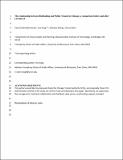| dc.contributor.author | Meredith-Karam, Patrick | |
| dc.contributor.author | Kong, Hui | |
| dc.contributor.author | Wang, Shenhao | |
| dc.contributor.author | Zhao, Jinhua | |
| dc.date.accessioned | 2024-08-30T15:39:22Z | |
| dc.date.available | 2024-08-30T15:39:22Z | |
| dc.date.issued | 2021-12 | |
| dc.identifier.uri | https://hdl.handle.net/1721.1/156465 | |
| dc.description.abstract | As Transportation Network Companies (TNCs) have expanded their role in U.S. cities recently, their services (i.e. ridehailing) have been subject to scrutiny for displacing public transit (PT) ridership. Previous studies have attempted to classify the relationship between transit and TNCs, though analysis has been limited by a lack of granular TNC trip records, or has been conducted at aggregated scales. This study seeks to understand the TNC-PT relationship in Chicago at a spatially and temporally granular level by analyzing detailed individual trip records. An analysis framework is developed which enables TNC trips to be classified according to their potential relationship with transit: complementary (providing access to/from transit), substitutive (replacing a transit alternative), or independent (not desirably completable by transit). This framework is applied to both regular operating conditions and to early stages of the COVID-19 pandemic, to identify the TNC-PT relationship in these two contexts. We find that complementary TNC trips make up a small fraction of trips taken (approximately 2%), while potential independent trips represent 48% to 53% and potential substitution trips represent 45% to 50%. The percentage of substitution trips drops substantially following COVID-19 shutdowns (to around 14%). This may be attributed to a reduction in work-based TNC trips from Chicago's north side, indicated by changes in spatial distributions and flattening of trips occurring during peak hours. Furthermore, using spatial regression, we find that an increased tendency of TNC trips to substitute transit is related to a lower proportion of elderly people, greater proportion of peak-period TNC travel, greater transit network availability, a higher percentage of white population, and increased crime rates. Our findings identify spatial and temporal trends in the tendency to use TNC services in place of public transit, and thus have potential policy implications for transit management, such as spatially targeted service improvements and safety measures to reduce the possibility of public transit being substituted by TNC services. | en_US |
| dc.language.iso | en | |
| dc.publisher | Elsevier BV | en_US |
| dc.relation.isversionof | 10.1016/j.jtrangeo.2021.103219 | en_US |
| dc.rights | Creative Commons Attribution-Noncommercial-ShareAlike | en_US |
| dc.rights.uri | http://creativecommons.org/licenses/by-nc-sa/4.0/ | en_US |
| dc.source | Author | en_US |
| dc.title | The relationship between ridehailing and public transit in Chicago: A comparison before and after COVID-19 | en_US |
| dc.type | Article | en_US |
| dc.identifier.citation | Meredith-Karam, Patrick, Kong, Hui, Wang, Shenhao and Zhao, Jinhua. 2021. "The relationship between ridehailing and public transit in Chicago: A comparison before and after COVID-19." Journal of Transport Geography, 97. | |
| dc.contributor.department | Massachusetts Institute of Technology. Department of Urban Studies and Planning | |
| dc.relation.journal | Journal of Transport Geography | en_US |
| dc.eprint.version | Author's final manuscript | en_US |
| dc.type.uri | http://purl.org/eprint/type/JournalArticle | en_US |
| eprint.status | http://purl.org/eprint/status/PeerReviewed | en_US |
| dc.date.updated | 2024-08-30T15:35:32Z | |
| dspace.orderedauthors | Meredith-Karam, P; Kong, H; Wang, S; Zhao, J | en_US |
| dspace.date.submission | 2024-08-30T15:35:33Z | |
| mit.journal.volume | 97 | en_US |
| mit.license | OPEN_ACCESS_POLICY | |
| mit.metadata.status | Authority Work and Publication Information Needed | en_US |
